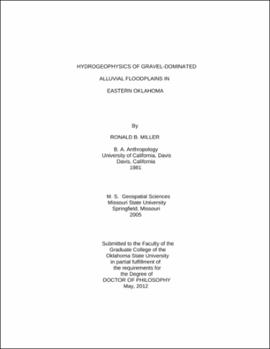| dc.contributor.advisor | Fox, Garey A. | |
| dc.contributor.author | Miller, Ronald B. | |
| dc.date.accessioned | 2013-11-26T08:29:50Z | |
| dc.date.available | 2013-11-26T08:29:50Z | |
| dc.date.issued | 2012-05 | |
| dc.identifier.uri | https://hdl.handle.net/11244/7112 | |
| dc.description.abstract | Scope and Method of Study: Geophysical and hydraulic surveys of three floodplains in eastern Oklahoma with the purpose of estimating floodplain heterogeneity and identifying high-flow domains or preferential flow paths. | |
| dc.description.abstract | Multi-electrode surface electrical resistivity (ERI) profiles of the floodplains show lenticular features with high resistivity within a domain of lower resistivity. Floodplain subsoil is composed of mixture of coarse and fine fractions (less than 0.25 mm). The proportion of the fine fraction from cores at the sites shows a negative power relationship with both resistivity (R 2 = 0.85) and hydraulic conductivity (R 2 = 0.72), suggesting that the fine content is the major factor in the hydraulic and electrical behavior of the gravel subsoil. A linear relationship between hydraulic conductivity and resistivity is significant and the resulting equation K sat = 0.11ρ; allows resistivity (ρ) to be interpreted as saturated hydraulic conductivity ( K sat ). The median hydraulic conductivity on all profiles from all sites was at least 20 m d -1 , which is within the range for gravel soils. This high hydraulic conductivity suggests that at least half of the subsurface at each floodplain is likely to behave as a "high-flow domain" with the ability to conduct water at rates of 20 m d -1 or greater. Several ERI profiles at Barren Fork Creek (BFC) had high resistivity values that were significantly higher than the remaining ERI profiles at BFC and the other sites measured at the 84 th percentile. Those ERI profiles were obtained from an area within the BFC study site where a trench injection test found a tracer (Rhodamine WT) to move in a manner that suggests preferential flow. A storm runoff pulse passed the BFC site over May 1-5, 2009 featuring 2.2 m of stage increase, which caused the water table to rise into the gravel-dominated vadose zone at the site. Water table maps, corresponding to the times when stream elevation matched the selected hydraulic conductivity elevations, were prepared from pressure transducers placed in monitoring wells at the site. It appeared that there was little attenuation of the energy of the storm pulse even at the furthest point in the study site: at 180 m from the stream the flood peak had only dropped 0.25 m and was delayed by 1.5 hours, suggesting that the floodplain was a "high-flow domain". Comparisons between depth slices of hydraulic conductivity, created by interpolating the ERI profiles, and the water table maps showed that areas of highest resistivity coincided with areas of relatively low water table slope and vice versa. Since high hydraulic conductivity implies less resistance to flow (and less loss of energy over distance), this is the response one would expect to see. Therefore, despite the floodplain as a whole constituting a high-flow domain, areas of preferential flow exist within the floodplain, characterized by highs in both hydraulic conductivity and resistivity. | |
| dc.format | application/pdf | |
| dc.language | en_US | |
| dc.rights | Copyright is held by the author who has granted the Oklahoma State University Library the non-exclusive right to share this material in its institutional repository. Contact Digital Library Services at lib-dls@okstate.edu or 405-744-9161 for the permission policy on the use, reproduction or distribution of this material. | |
| dc.title | Hydrogeophysics of gravel-dominated alluvial floodplains in eastern Oklahoma | |
| dc.contributor.committeeMember | Storm, Daniel E. | |
| dc.contributor.committeeMember | Halihan, Todd | |
| dc.contributor.committeeMember | Penn, Chad J. | |
| osu.filename | Miller_okstate_0664D_12140.pdf | |
| osu.accesstype | Open Access | |
| dc.type.genre | Dissertation | |
| dc.type.material | Text | |
| dc.subject.keywords | alluvial floodplain | |
| dc.subject.keywords | electrical resistivity imaging | |
| dc.subject.keywords | gravel | |
| dc.subject.keywords | hydraulic conductivity | |
| dc.subject.keywords | preferential flow path | |
| thesis.degree.discipline | Environmental Science | |
| thesis.degree.grantor | Oklahoma State University | |
